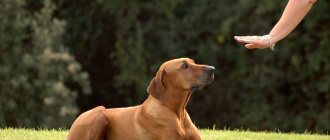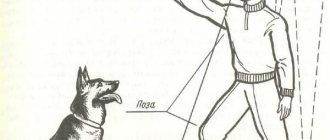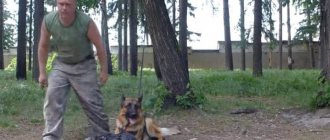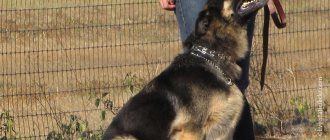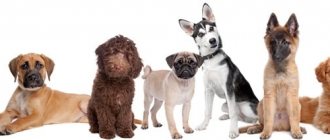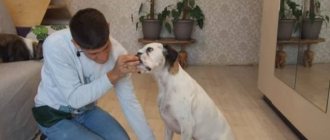Every owner, when purchasing a puppy, dreams that he will be an obedient companion and a faithful protector. But to make cohabitation comfortable, you need to work hard with your pet. Teaching your dog commands such as “front”, “sit” and “near” is not difficult, you just need to make an effort.
We recommend that you read important articles on the topic:
- How to train a dog: tips, rules, methods;
- Puppy training: effective methods from dog trainers, learning commands at home;
- How to properly train German Shepherd puppies: basic education from a dog trainer.
Why do you need to teach your dog the “Face” command?
Training in defensive commands
The literal translation of the command from German means “grab.” By pronouncing this command, the owner instructs the dog to attack the stranger and hold him until help arrives. This command is mandatory for guard dogs and dogs used in service.
It is studied with pets for the purpose of self-defense of the owner. Often in this way it is possible to stop and catch the attacker.
However, before starting training, it is worth objectively assessing the pet’s character. If he has a friendly, affectionate character, then mastering this skill will be more difficult for him. But for representatives of fighting breeds, learning this command will not be difficult.
A trained dog is better than an untrained one
However, there is such a circumstance. If you have purchased a pet with a high level of innate working qualities for protective work, then now you simply must go with him to the training ground. After all, you can’t crush genes with your finger, which means they need to be directed in the right, correct direction. The opinion that a dog will be able to protect you under any circumstances without training is very erroneous. A sufficiently experienced or simply desperate person will force her to retreat, evade the fight, and all defense will look like an angry bark at a safe distance. On the contrary, a dog that has been properly trained in skills knows how, and knows how to emerge victorious from a fight.
If you are not confused by all the listed warnings and circumstances, then we will continue to understand.
Will the dog become aggressive to others?
If certain rules are followed, the dog will not behave aggressively towards others. To get an adequate reaction to the “front” command, you should use the following tips:
- It is recommended to start training at one year of age;
- puppies should be taught the skill of returning toys at the request of the owner;
- In most guard breeds, distrust of others has already become an innate instinct, so there is no need to specifically provoke them into aggression. In this case, you need to teach them to control their pressure and behavior.
The “Face” command is based on causing aggression in the dog towards a specific person.
Therefore, experts advise taking into account the pet’s character during the training process. Training will be easier if the owner has become a friend to the dog. Important! “Fas” is considered one of the most difficult teams, so many turn to specialists.
Strong Grip Training
Requirements
Proper training will require strict fulfillment of the requirements, close psychological contact with the dog and training.
The first thing the owner must understand is the command “Face!” when performed correctly, it leads to an animal attacking another person, so it should be used only as a last resort.
Required skills before learning the command “Face!”
First of all, you need to teach the shepherd the rules of normal behavior on the street and with the owner, otherwise it will show anger at its own discretion. Under no circumstances should you command “Fas!” on friends, relatives, or passers-by who do not pose a threat.
Teach your German Shepherd the command “Fast!” possible at any age, starting from five months, but first you need to complete a general “Obedience” training course, which includes a number of commands and exercises:
- Commands “Sit!”, “Lie down!”, “Stand!” help control the dog when moving around the city;
- "Give!" — prevents aggression towards the owner when trying to take away a treat or toy;
- "Ugh!" (or any analogue) – cancels the current activity, and ideally, the attack;
- "Place!" - a difficult exercise for such an active dog as a German Shepherd, which increases endurance.
Unable to obey, a dog can use its anger against its owner or others. It is extremely difficult to teach an adult dog the basics of behavior, so initial training should be started from the first days of communication with the purchased puppy (according to FCI standards, the legal sale of a puppy with documents is possible from two months).
Psychological contact
To successfully train your pet and get satisfactory results, you need to establish psychological contact. If a dog has a strong sense of attachment to its owner, it will be able to concentrate its attention on it, and will quickly perceive information and remember its actions.
A close emotional connection will also ensure that the pet, without prior training, will be ready to protect the owner, but it is still better for this process to be controlled.
Professional dog trainer or lessons at home
There are owners who are ready to entrust the training process to a professional. Now you don’t have to bring your pet to a separate area. A dog trainer can come to your home and conduct training in a comfortable environment for the dog.
One lesson is not enough for the dog to learn the command. A whole course is required, which often includes behavior correction. The cost of the lesson depends on the characteristics of the breed and the content of the program. The standard course includes training in basic commands, including “fas”.
Important! The number of classes depends on the intellectual characteristics of the dog. The higher they are. The fewer lessons she will need to learn a new skill.
The cost of one lesson for representatives of small and decorative breeds with a dog handler visiting your home in the regions of the Russian Federation is about 1000 rubles, in Moscow and the Moscow region the price is higher - 1600-1800 rubles. The price of one lesson for dogs of medium and large breeds starts from 1,500 rubles. and can reach 3,000 rubles.
Training of defensive commands
Wolfhounds are also shepherds
To teach anger to representatives of large herding breeds, you need to take a fundamentally different approach. The history of the development of CAO and CO goes back more than a thousand years, during which time they have developed not only a stable phenotype, but also character traits that are often inherited. When training such dogs, you need to take into account their characteristics:
- slowness. German Shepherds are capable of performing up to 20 commands per minute because they have a lighter build. Do not expect from a Caucasian or Alabai that he will immediately carry out any of your commands, give him time to change position;
- self-will. The wolfhound is a dog with a temper; it always sees the world in its own way, and often decides for itself when it is necessary to show aggression. Often, without any training at all, they are able to track a threat and respond to it in time. The owner must clearly suppress any attempts to attack without a command, including when driving on the street. Aggressive male dogs (especially Caucasian Shepherd dogs) must wear a muzzle during the period from 9 to 18 months. At the same time, you cannot scold for an attack, you only need to stop the attack by jerking the leash with a short shout;
- weight. An adult dog weighs from 40 to 80 kilograms, depending on gender and origin (more weight is considered overweight), so the person taking the attack on the pet must be well physically prepared.
It is important to remember that the Central Asian Shepherd most often attacks not on the sleeve, as the defendant suggests, but on the most vulnerable places of the body, including the carotid artery. Therefore, for training with wolfhounds, a full suit is required that covers all limbs, body and head.
Features of training Central Asian and Caucasian Shepherds
It is often difficult to train a Central Asian or Caucasian to attack through a rag or directly on a sleeve; they simply do not understand why a person is offering them a safe cloth. They are equally poorly accustomed to fetching and rarely appreciate toys, focusing more on the owner or treats. In this case, the person involved must fake an attack to provoke a response. Therefore, it is better to start classes on anger at 9 months.
Some dogs tend to get angry. Among the Alabai, such behavior is less common, since their main task is to drive away the enemy, and not to destroy. Caucasian Shepherd Dogs were bred to guard the perimeter of mountain castles; for centuries, aggression and the desire to destroy the enemy were cultivated in them. Their attacks can be frantic, so both the owner and the dog handler must take into account all the behavioral features of large wolfhounds.
Preparatory stages of training
If the owner decides to independently train the dog for the “Fast” command, he must understand that this is one of the most difficult commands. With the wrong approach to training, the animal can become dangerous even for the owner. For training you will need the following equipment:
- protective suit;
- a piece of durable fabric;
- a strong stick or rod.
It is necessary to allocate a place for training and fence it off or build fences from improvised means.
Important! No one else should enter this area except the trainer and the dog. Only by agreement can you invite a person unfamiliar to your pet to practice the skill.
It is also worth taking care of a place where you can tightly tie the animal. After the dog understands the command, you can move the training to a more crowded place. But the situation should always be under control in order to prevent the negative consequences of training.
Protective sleeve
Who will train the pet?
Based on your experience and the character of your pet. Mistakes in training can lead to irreversible consequences.
The owner himself
This option is suitable for experienced dog breeders who are ready to take full responsibility for the actions of their pet. Remember that you will still have to work in pairs, so make sure you have several assistants in advance.
Dog handler
Classes with a dog handler guarantee not only safety, but also faster results and also save your time. You should seek help if you have no experience in raising dogs, as well as when training silently attacking and dominant breeds. Such animals include the Caucasian Shepherd Dog and the Fila Brasileiro.
Protective guard service course
The ZKS course is designed for service dogs, so its program includes not only the detention, but also the escort of an attacker into the hands of law enforcement agencies. Four-legged animals over 1 year old who have successfully passed the OCD and medical examination are allowed to participate in training. This option is suitable for pets who will work in the police, customs or search and rescue operations.
“ Read more about the ZKS course
Generally accepted teaching methodology
During training, you need to adhere to a clear algorithm of actions so that the dog’s skill is established correctly. When teaching the “fas” command, the sequence of steps will be as follows:
- Tie the dog securely. The trainer stands next to her, and the assistant stands to the side. He must hold a cloth and a stick in his hands.
- Making noise, he slowly approaches the dog.
- She begins to show signs of aggression.
- At this moment the trainer gives the command “front”. If the dog reacts to it, you need to give a treat or simply praise it.
- The assistant continues to attack the pet, quietly hitting her with a stick or rod.
- When the dog tries to grab the stick, he is given a rag, which he begins to tear.
- At this moment, the assistant needs to fight for the rag. At the same time, the coach commands “front”.
- As soon as the dog takes the flap, the helper runs away from it.
- The pet needs to be praised.
This exercise needs to be repeated several times. The average lesson duration is an hour and a half. The main thing is to prevent the animal from becoming too aggressive.
Training using a stick
Various techniques
There are several methods for teaching your pet the front command yourself.
All of them are trained on a leash.
Method 1
- The dog stands next to the owner on a soft collar or harness.
- The assistant comes out of hiding and begins to sneak up on the animal, bending down and arousing suspicion with his behavior.
- The owner encourages the dog with the command “stranger”.
- Having approached five steps, the assistant turns around and runs away, the dog tries to grab him, the command “Face!” is given.
This technique is well suited for insecure, timid animals. There is no direct interaction with the enemy.
Method 2
- The pet is on a leash, a favorite toy or bone lies nearby, the assistant walks by, pretending to try to grab the thing.
- The dog begins to break from the leash, trying to bite the intruder, pronouncing “fas!”
The method works well with angry, suspicious dogs.
Method 3
- The dog is tied to a post or tree, the owner stands nearby.
- The assistant passes by several times, teasing the dog with a rag and running away, the owner says “stranger.”
- When the pet gets angry, the assistant approaches the owner and pretends that he wants to attack him.
- The owner shouts: “Face!”, pushes the enemy away; if the dog tries to bite, the rag is given to it, and the assistant “runs for his life.”
Method 4
- In the courtyard of a private house, you can stage an attempt to break in by robbers.
- To do this, the assistant makes suspicious noises and rustles behind the fence, tries to look into the yard, opens the gate and sticks his jacket through it.
- Attempts by a pet to grab a thing, barking at a stranger are encouraged by the word “stranger!”
- This lasts no more than five minutes, then the dog is put on a leash, the owner takes it out the gate, and at the command “Face!” begins to pursue the assistant.
You can let the dog catch up with the person and grab the rag or jacket that he leaves behind.
Stages of training
The stages of training will differ depending on the pet's age and personality traits. The “front” command is one of the most aggressive, so training must be taken very seriously.
Puppy training
You can form a base as early as one and a half to two months. But there can be no talk of any provoking aggression. You also need to temporarily abandon any imitation of an attack.
During this period, it is necessary to focus on strengthening the prey instinct. To do this you will need your puppy's favorite toy. You need to play with him, stopping actions at the most interesting part. Thus, the owner will encourage him to continue the game on his own by grabbing and pulling things.
Important! It is necessary to create a situation of success so that the puppy does not lose interest in such a pastime.
The purpose of such exercises is to strengthen the dog's grip. Also at this age you can teach the commands “fu” and “give”. After this, you can move on to another stage of training.
Training an adult dog
First you need to let the dog familiarize itself with the territory. After this he is tied up. Two people take part in the training: the trainer and his assistant. When the latter begins to approach, it is necessary to say “stranger” in a provoking tone. This is necessary to practice the “fas” command.
The helper must attract the dog with strange actions - nervous behavior, waving a rag. As soon as the trainer feels the animal’s tension, he should say “fas.” After the dog grabs onto the protective sleeve or rag, you need to praise him. Then say “ugh” and take him back. Thus, it is necessary to repeat the exercise several times.
The same thing needs to be repeated after untying the animal. But the trainer must keep the whole situation under control so that the dog’s actions do not harm the assistant.
Service dog training
Development of interception
The trainer holds the dog on a short leash. The assistant teases him at this time, then runs away. Next, the dog handler gives the command “Face”, and together with the dog they chase the assistant. When there is a small distance between the dog and the runner, the latter turns half a turn and exposes his sleeve to the dog.
If the animal grabs it, then the assistant pulls it a little closer to itself in order to strengthen the grip. He then takes a couple of steps closer to the dog to stop the pull, and raises his other sleeve over the dog's head to strike. The dog, seeing danger approaching, intercepts it. You need to repeat the exercise three times. As soon as the dog handler pronounces the command “Stop,” the fight stops. After which the dog is calmed down, encouraged and taken a few steps away from the “enemy”.
First actions
Before teaching a dog the “face” command, it must know the “obedience” commands. These include “fu”, “place”. Usually they are taught to puppies. It is also worth assessing the character of your pet, because cowardly and overly affectionate and sociable dogs are more difficult to provoke into aggression.
Therefore, it is necessary to visit a dog handler periodically. He will evaluate the pet’s behavior and will be able to adjust the training process in a timely manner. The best time to start training is when the dog is completely focused on training and the training itself.
You can begin the non-game stage after the pet begins to confidently carry out preliminary commands. Working with an assistant requires special control.
Nuances when training
A dog performing the function of a guard must have some malice and aggressiveness of character, which should be directed at the person who poses a certain threat, and not at other domestic animals. Of course, such character traits are natural, inherent in a dog from birth, so representatives of some breeds will never be able to become a real watchman and protector. Accordingly, this feature should be taken into account.
You can begin the training process when the puppy has reached the age of five months. However, in some situations, an adult can also be trained. There are a number of recommendations that can be followed by the owner to be able to carry out training more effectively:
- In accordance with established standards, teaching a dog the commands necessary to perform the function of protectors is possible only when the animal has mastered all the mandatory and initial commands. The dog requires considerable restraint and impeccable obedience to the owner. If practically no time was spent on raising a pet, then you don’t have to think about teaching it protection, since a dog that does not obey its owner will not provide it with high-quality protection.
- A command that involves further learning of orders is “Alien!”, which can prepare the animal for the development of a conflict.
- A dog that acts as a protector must have good health, endurance and strength, so it is important to give him a chance to receive regular exercise, periodic walks and a nutritious diet.
- It is important that complete mutual understanding is established between the dog and the owner. An animal that loves a person and is attached to him as much as possible will do everything to protect the owner.
Any mistake, even the most insignificant at first glance, can result in the dog’s psyche being in jeopardy, so it is important not to “go too far” when training your pet.
Team training
After the preparatory work, they move on to practicing the skill on a person. The assistant must wear a protective suit to avoid injury during training.
"Intruder"
The assistant must behave defiantly and play the role of an attacker on the dog. As soon as the animal is sufficiently angry, the command “Face” should be given. After waiting until she grabs the sleeve or stick, command “fu”.
Practicing the “fas” command
Optimal distance
You cannot come closer than 3 m. This distance is considered safe for such training.
Prohibited areas of the body
The dog must attack the protective sleeve. It is prohibited to approach the animal’s face, neck and groin area.
Command "fu"
It is needed so that the dog releases its “prey” at the first request of the owner.
Leash refusal
You can move to this stage only when the pet releases the enemy on the command “fu”.
Possible mistakes
During the training process, not everything may go as smoothly as we would like. The trainer needs to take this into account and try to avoid possible mistakes:
- Do not force your pet to train if it does not behave confidently. It is better to first work on the psychological state of the animal;
- Do not scream or get angry with your pet, as this can intimidate it even more. It is better to show confidence in your actions, and then the dog will feel it. Showing excessive emotionality is also useless;
- Don’t throw around the “Alien” command just for fun. The dog will either stop perceiving it completely, or will begin to show aggression towards everyone.
Attack of a fleeing enemy
This skill is even more difficult to teach than the “fas” command. As soon as the dog has caught up with the “intruder”, it must throw him to the ground and bite him until he stops resisting or until the command “fu” is said.
Important! At the same time, the dog is taught to assess the situation and attack correctly depending on the degree of threat to the safety of the owner or any of the family members.
Happy pet
Necessary information
In fact, upon hearing the command “stranger,” the dog should under no circumstances rush at the newcomer. It is enough that he becomes wary, growls or starts barking loudly. That is, this task does not encourage the dog to take active action, but is only a signal to show alertness - the pet must be prepared for any outcome.
The dog should master this skill no earlier than he has mastered a set of basic commands - “place”, “sit”, “give me a paw”, etc. Moreover, he can begin training if he completes the remaining tasks the first time, unquestioningly obeying. Serious training should take place no earlier than six months, since the early development of viciousness or aggressive behavior can cause the dog to become nervous and intimidated.
Features of breeds
The easiest way to teach this command is to shepherd dogs - following protective commands is inherent in them at the genetic level. Representatives of small and decorative breeds, for example, Yorkshire Terrier, Chihuahua, are more difficult to train. They don’t need this skill as much, so training takes longer. And these breeds have a higher chance that improper training can make them uncontrollable.
There are special training courses for hunting breeds such as Labradors. They are aimed at capturing and pursuing game. A separate group should include service dogs, whose training is carried out by professional dog handlers.
Features of training German and East European Shepherds
It is this breed that many people associate with the concept of “Shepherd,” although in fact the history of its development does not even go back two hundred years. She, and the East European Shepherd based on her, are willing to demonstrate obedience, and rarely try to dominate the owner. Their disadvantage can be called excessive energy - owners must be prepared for constant walks, fetch exercises, physical activity and anything that will help shake out excess energy.
Often, VEO or German Shepherd puppies are too excited to exercise properly, so they need to run out before exercise. The owner can go for a run, use a bicycle, or play catch-and-fetch with the pet, throwing their favorite toy away from themselves. Dogs of these breeds are classified as service dogs, so they are in constant demand among police dog handlers and border guards.
What the professionals say
Dog trainers are confident that the “face” command can be taught to representatives of any breed, even a mongrel. But before you start training, you should carefully study the characteristics of your dog: for some, attacking a person is unnatural. It is better not to train such dogs to attack.
Attention! Don't forget to praise your pet if he followed the command. But overly aggressive behavior should not be encouraged.
There is no need to let the dog off the leash at first, because it needs to be given time to learn a new skill.
Training is a complex process that is not limited to one training session. It is not always possible to cope on your own, so they invite professionals. You should say “fas” to a dog when you need to protect the owner or his loved ones. Then the pet will be safe for others.
Actionable tips
If the animal cannot be trained due to the characteristics of the breed, an alternative should be used:
- You can train an overly friendly dog to bark on a command that only you two understand. When a suspicious person approaches, it’s worth reporting him. Usually this is enough for the person to leave.
- If your pet does not want to be a guard, you can get a second small dog. They are usually sensitive and warn of approaching danger. Then the pet will also react by barking and scare the ill-wisher with its appearance.
A dog should not be turned into a dangerous weapon. Otherwise, the dog will become a threat to others. It is important to realize your own responsibility for your pet’s actions.
Conditions of detention
A dog raised to protect the home and family members must be fed properly and kept in proper conditions. Choose balanced food for the animal. You cannot fatten the animal; it must always be in shape.
It is important to monitor the animal’s health, do all vaccinations on schedule, and regularly show your pet to the veterinarian.
Protection of family members
After practicing the voice orders “fas” and “fu,” all family members, including children, are involved in the training process. The animal must learn to protect them too. This will protect loved ones from being attacked by a pet.


